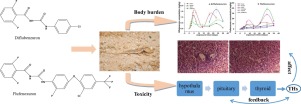Journal of Hazardous Materials ( IF 13.6 ) Pub Date : 2018-01-04 , DOI: 10.1016/j.jhazmat.2018.01.005 Jing Chang , Jitong Li , Weiyu Hao , Huili Wang , Wei Li , Baoyuan Guo , Jianzhong Li , Yinghuan Wang , Peng Xu

|
Dermal exposure is regarded as a potentially significant but understudied route for pesticides uptake in terrestrial reptiles. In this study, a native Chinese lizard was exposed to control, diflubenzuron or flufenoxuron contaminated soil (1.5 mg·kg-1) for 35 days. Tissue distribution, liver lesions, thyroid hormone levels and transcription of most target genes were examined. The half-lives of diflubenzuron and flufenoxuron in the soil were 118.9 and 231.8 days, respectively. The accumulation of flufenoxuron in the liver, brain, kidney, heart, plasma and skin (1.4-35.4 mg·kg-1) were higher than that of diflubenzuron (0-1.7 mg·kg-1) at all time points. The skin permeability factor of flufenoxuron was more than 20-fold greater than that of diflubenzuron at the end of exposure. However, the liver was more vulnerable in the diflubenzuron exposure group. The alterations of triiodothyronine (T3) and thyroxine (T4) level after diflubenzuron or flufenoxuron exposure were accompanied with the changes in the transcription of target genes involved not only in hypothalamus-pituitary-thyroid (HPT) axis (sult, dio2, trα and udp) but also in metabolism system (cyp1a and ahr). These results indicated that flufenoxuron produced greater body burdens to lizards through dermal exposure, whereas both diflubenzuron and flufenoxuron have the potential to disturb metabolism and thyroid endocrine system.


























 京公网安备 11010802027423号
京公网安备 11010802027423号